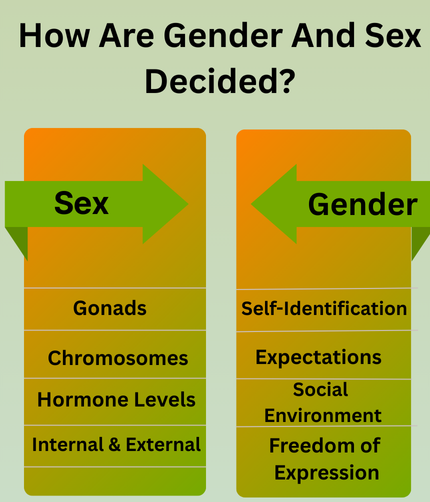Introduction:
The sex of an individual is usually determined at birth by physiological traits such as chromosomal makeup and genitalia.
Contrarily, gender refers to an individual’s identity. Rather, this is a wide range. Anywhere along this spectrum or completely outside of it is where a person can identify.
Transgender, nonbinary, and gender-neutral are some examples of these identities. An individual might describe their gender in a variety of ways.
Social constructions of gender, such as gender “roles” or “norms,” also exist. This is a reference to the biological distinctions between men, women, and intersex people based on reproductive anatomy, hormones, and chromosomes.
It is usually given at birth and is regarded as a biological category. But not everyone falls neatly into the male or female categories, and biological sex itself can be a continuum.
It describes the duties, conduct, standards, and identities that society views as fitting for either men or women, or for those who do not exactly identify with either. This is influenced by one’s culture, upbringing, and life experiences; it is neither fixed nor exclusively dictated by biology.
As our understanding of human identity develops, more individuals are realising that gender is not a rigid binary but rather a varied and flexible spectrum.
What Exactly Does the Term “Sex” Mean?
The biological and physical traits that set male, female, and intersex people apart are referred to as “sex.” When determining a person’s sex at birth, doctors usually look at these outward characteristics.
The complete complexity of human biology, however, is not always taken into consideration by this classification, particularly when a person is born with intersex traits—differences in sex characteristics.
This is significant in fields like reproductive biology, public health, and medicine because specific biological characteristics may be necessary for the treatment of particular illnesses.
But it’s equally critical to avoid confusing sex with gender since doing so might obscure the lived experiences of people whose gender identification differs from the sex they were given at birth.
Despite this intricacy, a lot of organisations and civilisations continue to mostly depend on binary categorisation, frequently ignoring the variety of human biology.
What Exactly Does the Term “Gender” Mean?
“Gender” is the term used to describe the socially created identities, roles, behaviours, and expressions that a society deems suitable for individuals depending on their perceived sex.
Gender is not universal nor set, as evidenced by the wide range of cultural and historical variations in these expectations.
This is the external presentation of a person’s gender through their voice, mannerisms, haircuts, and other self-expressions.
This change in perspective promotes policies and attitudes that are more inclusive and honour people’s many identities.
A more fair and realistic understanding of human variety may be achieved by acknowledging that gender is influenced by personal, cultural, and societal variables rather than being only defined by genetics.
This is about individuality, independence, and the right to self-definition, not merely classification.
Does Sex Just Exist As Male Or Female?
Many individuals had the long-held belief that biological sex is limited to two categories: male and female. In culture, law, and healthcare, this dichotomy is still prevalent. However, sex is not strictly binary, as demonstrated by scientific and medical advancements.
The most widely used sex categories, male and female, do not fully capture the variety of biology. Social policy, healthcare, and education may all be made more inclusive by acknowledging that sex is not completely binary.
Additionally, it guarantees that individuals whose bodies do not conform to traditional notions of male or female are valued, comprehended, and assisted.
Does Gender Have a Binary Form?
This perspective identifies being male with masculinity and being feminine with femininity. These binary roles frequently include rigid standards for how individuals should act, dress, talk, and even think according to the sex they were assigned at birth. This binary concept has had a significant historical impact on institutions, laws, religions, and social systems.
As a result, although gender may seem binary in many Western or mainstream situations, it is a socially created, flexible term that differs among people and cultures. Acknowledging this supports diversity, tolerance for different identities, and the right of people to choose their gender.
These identities acknowledge that there are many distinct manifestations and experiences of gender, which are not restricted to only two categories.
How Are Gender And Sex Decided?
Here’s a thorough breakdown of the decision-making process for gender and sex, including how they vary:

- Sex
Biological traits, namely the look of external genitalia, are usually used to assign this at birth. Medical practitioners use these outward characteristics to determine whether a newborn is male or female. In certain situations, additional medical testing may be necessary, particularly if there are indications of intersex features or ambiguous genitalia.
- Gonads
Sexual reproduction depends on gonads because they produce the cells needed for fertilisation. Additionally, they affect sexual development during puberty by secreting sex hormones.
The gonads may not fit into the conventional male or female classifications in people with intersex disorders. People may have gonads or ovarian and testicular tissue that may not match their chromosomal sex or external genitalia, for example.
- Chromosomes
Every human cell’s nucleus contains chromosomes, which are organelles that contain DNA, the genetic material. The 46 chromosomes that humans normally possess are grouped into 23 pairs.
A person’s sex and distinctive features are determined by these chromosomes, along with the majority of their basic attributes.
Chromosomes are a crucial, if occasionally complicated, component of sex determination and human variety because of their variations.
- Hormone Levels
The term “hormone levels” describes the concentration of certain hormones in the blood, which are important for controlling growth, development, metabolism, sexual function, and other vital bodily processes.
Numerous glands in the body, such as the pituitary, ovaries, testes, and adrenal glands, create hormones, which are chemical messengers. They impact nearly every cell and organ in the body, affecting everything from physical characteristics to emotions.
As people age, their hormone levels can also naturally fluctuate, particularly throughout puberty and menopause for those who were born with a female gender assignment or andropause for those who were born with a male gender assignment.
- Internal & External
Anatomical elements of the body, especially those associated with sexual and reproductive traits, are referred to as internal and external aspects. These features are important in biological sex determination and sexual development.
Though they don’t always capture the complexity of a person’s biological sex, particularly for individuals with intersex problems, these outward characteristics are frequently the most widely utilised indicators for determining biological sex at birth.
Although biological sex is frequently assigned at birth based on exterior characteristics, internal characteristics are essential for sexual development and reproductive health.
- Gender
Unlike sex, this is not allocated in the same biological manner. Instead, it is a social and psychological identity that is typically defined or discovered by the individual over time.
- Self-Identification
In contrast to biological sex, which is frequently dictated by physical traits such as genitalia or chromosomes, gender identity is a more flexible, internal notion that includes an individual’s experiences, feelings, and external manifestations of their gender.
The notion that gender may be flexible and self-determined may be difficult for some people to accept because of cultural, religious, or personal views.
- Expectations
Based on a variety of characteristics, including gender, sex, age, social roles, and cultural standards, expectations are societal, cultural, or personal opinions about how people should act, appear, or interact.
Pressure to fit into a specific stereotype of what it means to be a man or woman might eventually result from such expectations, which can limit personal freedom and expression.
It may be a transforming process to challenge these assumptions, resulting in increased equality and personal freedom.
- Social Environment
Every social and cultural element that affects people’s lives, actions, and identities is referred to as the social environment. Family, friends, peers, schools, communities, and the larger society are all included in this, as are the people, organisations, and cultural norms that surround an individual.
People may feel more capable of expressing themselves outside of the binary gender classifications of male or female, for example, in a progressive setting where gender is viewed as flexible.
- Freedom of Expression
People may freely express their ideas, opinions, identities, and beliefs without worrying about censorship, discrimination, or retaliation because of this basic human right.
Being able to openly express one’s gender identity is crucial for both personal fulfilment and mental health. From one’s speech and attire to one’s interactions with people or participation in social events, this term may cover it all.
Why Does It Matter To Understand Sex?
Knowing the basic scientific facts regarding chromosomes, hormones, and reproductive organs is not enough to comprehend sex. It entails acknowledging how sex shapes social relationships, personal identity, and health consequences, as well as how laws and cultural norms may both empower and restrict people based on their sex.
Understanding sex from a wider perspective—one that takes into account not just biology but also gender, social norms, and human rights—will help us better assist people in leading genuine, healthy lives free from prejudice and social restrictions.
The biological variability of sex can assist in preventing needless operations or procedures that aren’t in line with the long-term health of the individual.
We shall attempt to provide you with a clear understanding of the words “sex” and “gender.” The similarities between these two terms will then be discovered. zudena pills are required for males with ED.
What Distinguishes Sex From Gender?
Awareness of human identity, societal roles, and interpersonal interactions requires an awareness of the difference between sex and gender. Even though these phrases are frequently used synonymously, they refer to rather distinct ideas.
In general, females generate more oestrogen and men more testosterone. Body hair, voice tone, and fat distribution are examples of secondary sexual traits that are influenced by these hormonal variations.
Biological elements, including chromosomes, hormones, and reproductive anatomy, determine this, whereas social, cultural, and psychological influences determine gender.
Acknowledging this difference promotes more acceptance and inclusion by assisting individuals in comprehending the richness of human identities and experiences.
Understanding the biological and cultural components of gender and sex allows us to better understand how people negotiate their identities in a changing and varied society.
Will Sex Evolve Throughout Time?
In the future, society’s definitions of sex and gender could be even more inclusive due to the rising acceptance of gender variation.
Legal regimes may change to acknowledge gender identities other than male or female, which would improve the legal and societal acceptance of a variety of identities.
Sex in the biological sense is mostly determined by environmental and genetic variables, and it evolves relatively slowly across evolutionary timeframes.
However, as countries grow more accepting of gender variation and less dogmatic about gender standards, the social constructions surrounding sex and gender change far more quickly.
Though the nature of sex itself might not change significantly shortly, our understanding and expression of it will.
We anticipate that our biological and social understanding of sex will continue to evolve, impacting our conceptions of gender, identity, and human relationships.
This is supported by the increasing acceptance of diverse gender identities, the development of reproductive technologies, and the growing awareness of intersex conditions.
Does a Person’s Gender Come and Go?
Gender is not necessarily fluid for everyone, though, and a person’s experience of their gender identity can differ significantly depending on their sentiments, cultural influences, and social settings.
Male and female traits may be combined in non-binary people’s gender identification, or they may be entirely distinct. Depending on where they are in life, their gender experience may change or feel different.
Even if a person doesn’t internally feel gendered under these standards, these roles can nevertheless have an impact on how they publicly portray their gender.
While gender identity is more solid and constant for some people, it can change and change throughout their lives for others. What is most important is that everyone has the flexibility to explore and express their gender in ways that seem authentic to them; there is no one-size-fits-all gender experience.
How Are Gender And Sex Similar?
Although they are similar, they differ in several ways. Let’s examine their similarities by first providing a broad summary and then going into detail.

- Gender
This is an intricate and multidimensional idea that is impacted by individual, societal, and cultural influences. Some characteristics are shared by people of all genders, even if they may identify as different.
However, gender refers to the social, cultural, and psychological characteristics that are associated with being male, female, or other gender identities in a given community. Socially constructed roles, behaviors, identities, and expectations are all included.
- Personal Identity
The idea of personal identity encompasses the traits, convictions, values, and life experiences that define each of us as people. It is a psychological and philosophical idea that is fundamental to how we perceive ourselves and our function in the universe. Personal identity changes as a result of our interactions with relationships, society, and the environment.
In general, the concept of personal identity is dynamic and complex. It reveals not just who we are right now, but also how we relate to our history and our goals for the future.
Cultural standards, gender roles, and historical settings are just a few examples of the wider societal elements that can influence our sense of personal identity and how we view ourselves and our place in society.
- Autonomy & Choice
Autonomy is the capacity to make choices that are consistent with one’s values, aspirations, and objectives. Being in charge of one’s own life makes it strongly tied to personal freedom. Being autonomous is having the freedom to behave in ways that are true to oneself, free from the excessive influence of others or society.
It goes beyond simply having the ability to make decisions. Ethics-wise, autonomy is frequently seen as a basic human right, as it is essential to one’s sense of self-worth and dignity.
In the healthcare industry, for example, respecting an individual’s autonomy entails allowing them to make decisions about their care, even if those decisions conflict with those of others.
- Form Relationships
A vital component of human life, connection formation is essential to social interaction, emotional health, and personal growth. Relationships enable people to connect with others, exchange experiences, and get support, whether they be romantic, platonic, family, or professional. A person’s identity is shaped, and a sense of belonging is given by these relationships.
Building relationships is crucial to fostering a feeling of community and belonging since humans are social creatures by nature.
Social bonds provide chances for communication, experience sharing, and understanding, which aid people in navigating life. A network of ties, whether familial or friendship-based, can give companionship and lessen feelings of isolation or loneliness.
- Human Experience
As individuals and as a species, we are defined by the variety of feelings, difficulties, experiences, and personal development that make up the human experience. It encompasses all that people experience, think about, come across, and learn during their lives.
Our relationships with other people impact our behaviours, help us define who we are, and give our lives purpose. Relationships are essential to our experiences of communication, conflict, love, and trust.
No matter how little the accomplishment, celebrating it gives people a sense of accomplishment and improves links between communities and individuals.
- Equality and Respect
Fostering inclusive communities, encouraging harmonious relationships, and making sure that people are treated with the dignity they deserve all depend on these ideas. They are all linked, yet they have different uses and meanings in relation to social ideals and human interaction.
Voting, healthcare, work, education, and other vital facets of life are all covered by this. According to the idea of equality, no one should be excluded from these chances or subjected to discrimination because of capricious or biassed reasons.
- Sex
Whether a person is intersex, biologically male, or female, we are examining common human traits when we talk about the similarities between the sexes.
All people have basic biological requirements, psychological wants, and social interests, regardless of their sex. By identifying these commonalities, we may get above the constraints of sex-based classification and promote a more compassionate and inclusive view of humankind.
- Genetic Material
The molecules known as genetic material are in charge of storing and transferring the biological information that establishes the characteristics and capabilities of every living thing. DNA is the genetic substance found in humans and the majority of other species, however, some viruses utilize RNA.
Cellular development, inheritance, and daily operations are all significantly influenced by genetic material.
The components of cells that produce energy, the mitochondria, also contain a little amount of genetic material.
Proteins, which are necessary for cell structure, function, and control, are made using instructions found in DNA.
- Emotional Needs
Our mental health, personal growth, and wholesome relationships all depend on our emotional needs, which are psychological prerequisites. For our minds and emotions to flourish, we require emotional fulfilment, just as our bodies need food and water to exist. We feel more content and stable when these needs are satisfied because they enable us to feel safe, appreciated, and connected.
Strong relationships, personal fulfilment, and good mental health are all more likely to occur when emotional demands are satisfied.
Feelings of loneliness, anxiety, despair, relational problems, and insecurity can result from unfulfilled emotional needs.
- Human Rights
Human rights are fundamental freedoms and rights that every individual has simply by being a human. All persons are entitled to these rights, which are unalienable and universal, irrespective of their gender, race, nationality, religion, language, or any other status. They are necessary to maintain social fairness, equality, freedom, and dignity.
Human rights are the cornerstones of justice, peace, and freedom. Regardless of their identity or place of residence, they guarantee that each person is treated equally and with dignity. Everyone must uphold and advance human rights; everyone in society must take action, show respect, and be dedicated to this cause.
Every individual has the right to vote and participate in public affairs, either directly or through representatives who have been chosen by the people.
- Biological Repair
To preserve their health and survival, living things naturally identify and repair damage to their cells, tissues, and organs. This process is known as biological repair. Every level of biological organisation is affected by this crucial process, which ranges from DNA molecular repair to the regeneration of whole tissues following damage.
To preserve the integrity of the genome and fend against illnesses like cancer, the body employs a number of repair processes, including base excision repair, nucleotide excision repair, and mismatch repair.
Salamanders and other creatures possess the amazing ability to regenerate complete limbs, although humans have a limited capability for regeneration, particularly in the liver, which may recover significant sections following damage.
- Physical Vulnerability
Because of its biological constraints and exposure to external hazards, the human body is susceptible to harm, injury, or sickness. This is known as physical vulnerability. In many respects, we are still physically vulnerable despite our increased intelligence and technological sophistication.
While some infections are preventable through immunisation or good cleanliness, others remain and pose serious risks, particularly to those with compromised immune systems or no access to medical care.
Additionally, long-term susceptibility to hereditary factors, unhealthy lifestyle choices, and environmental contaminants is shown by chronic illnesses, including cancer, diabetes, and heart disease.
Because of structural inequalities, marginalised people may suffer disproportionately, giving physical vulnerability a social component.
Are Gender And Sex Changeable?
In addition to a person’s internal sense of self, gender also describes the duties, actions, and expectations that society places on individuals depending on their perceived sex.
It is allowed in many nations for people to alter their gender on identification documents such as passports and ID cards.
Transgender people can modify their physical characteristics to better reflect their gender identification through sex reassignment or gender-affirming operations, which include hormone medication and surgery.
Some individuals have sex traits that are not typically classified as male or female from birth. This calls into question the notion that sex is rigidly binary or fixed.
So while biological sex cannot be fully changed at the chromosomal level, many physical aspects of sex can be modified to align more closely with an individual’s gender identity.
There is a clear demarcation between sex and gender based on chromosomal variations and physical characteristics. Gender has a far more speculative definition that is related to our emotions, culture, perceptions, and other elements.
The same technique is used by both men and women to stimulate themselves to have intimate relations. The Ajanta ED trial pack can be used by any guy who has erectile dysfunction to see which medication works best for them.
The greatest deals on ED medications, such as malegra 200, can be found on Medypharmacy.
























